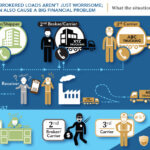Every trucker is familiar with the three basic pieces of paperwork needed to get paid on a load:
- an invoice,
- a rate confirmation sheet, and
- the bill of lading.
The invoice and rate confirmation sheet are typically standard-form items that don’t need much effort by the carrier to be filled out properly. But if truckers aren’t careful, the bill of lading is one area where they can quickly become a victim.
Because the bill of lading is such a routine piece of paperwork in the transportation industry, its importance is easily overlooked. The bill of lading, however, should be thought of as a carrier’s first line of defense against double-brokering. Double-brokering is when a freight broker reposts another freight broker’s load on its own rate confirmation sheet. Double-brokering is illegal and designed to steal from the actual carrier of the load.
How a Trucking Company Can Protect Itself with a Bill of Lading
There is one simple step that trucking companies, especially owner/operators and other small carriers, can do to protect themselves from becoming victims of a double-brokered load. A bill of lading needs to have three signatures on it: the shipper’s, the carrier’s, and the receiver’s. The shipper’s signature says that the quantity and quality of the loaded goods meet the industry standard. The carrier’s signature verifies that when he received the load the cargo was in good condition. The receiver’s signature verifies that the goods have been received at the delivery location. Sometimes, the receiver will use a stamp instead of having someone sign for the goods.
Now while the signatures of the shipper, carrier, and receiver are all necessary for the bill of lading to be valid, there’s one more thing a carrier can do to get paid on a load and avoid becoming a victim of double-brokering. Every carrier should also write the carrier’s company name and MC number below the driver’s signature. If a load has been double-brokered, this should raise a red flag to whoever is paying the load as to who truly carried the load. The original freight broker paying the load should see that the carrier’s MC number and trucking company name don’t match the carrier they have on file. That broker should reach out to the true carrier to arrange payment.
Some trucking companies have created a stamp with their company’s name and MC number. This makes it easier for the true broker of the load to identify the carrier and ensure that the carrier is paid, not the double-broker. Please, help work against companies that are double-brokering—put your MC number and company name on every bill of lading.

